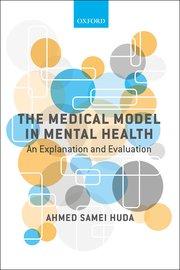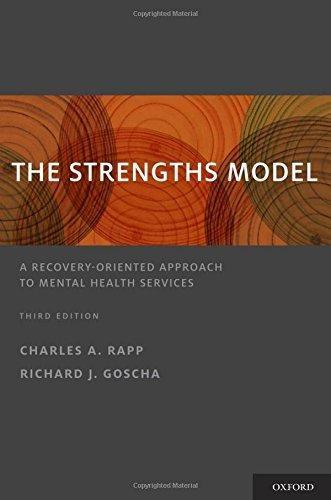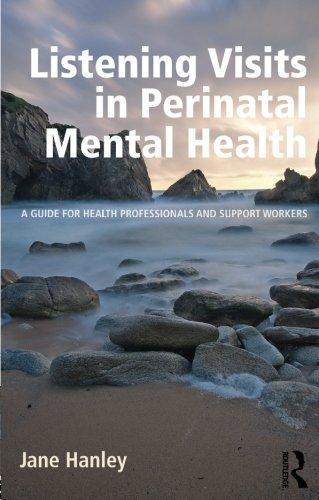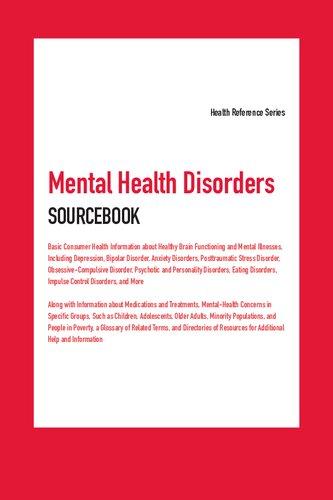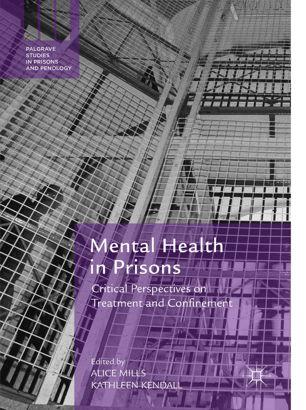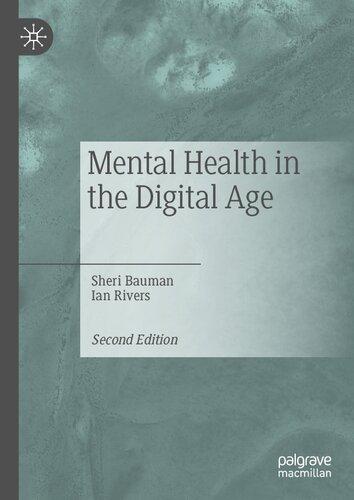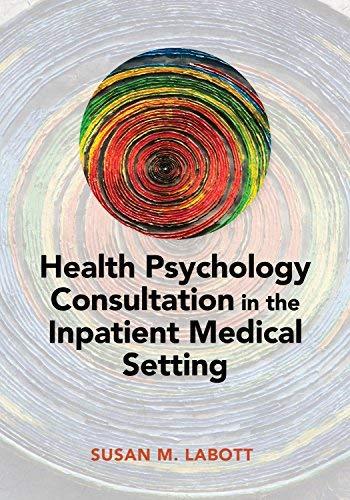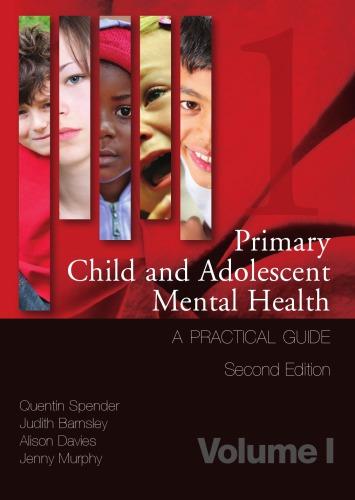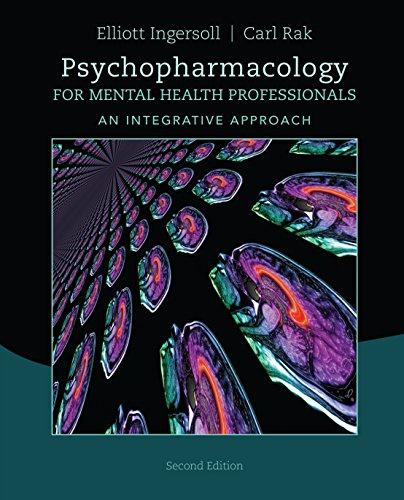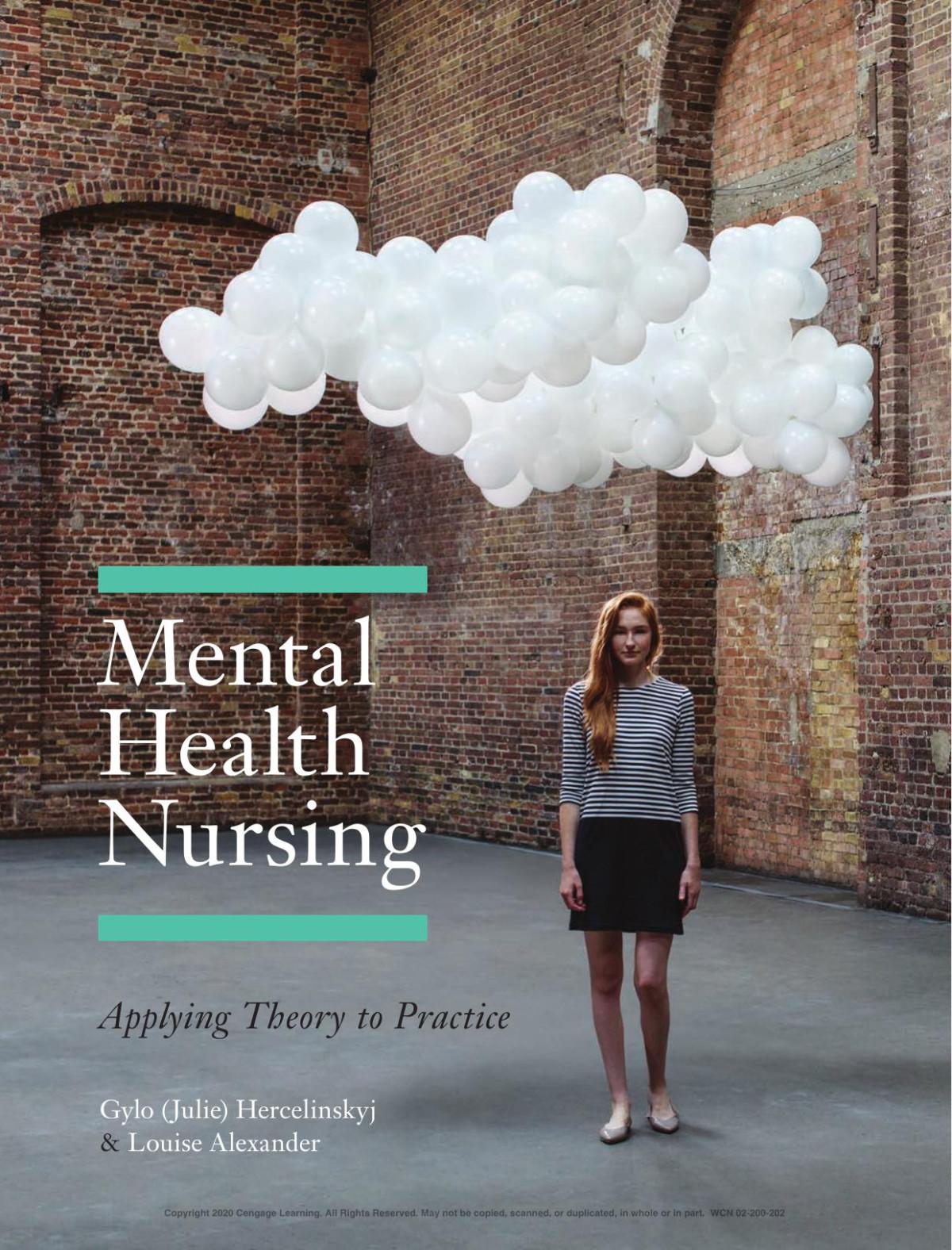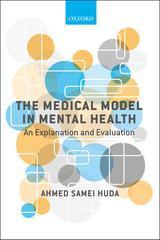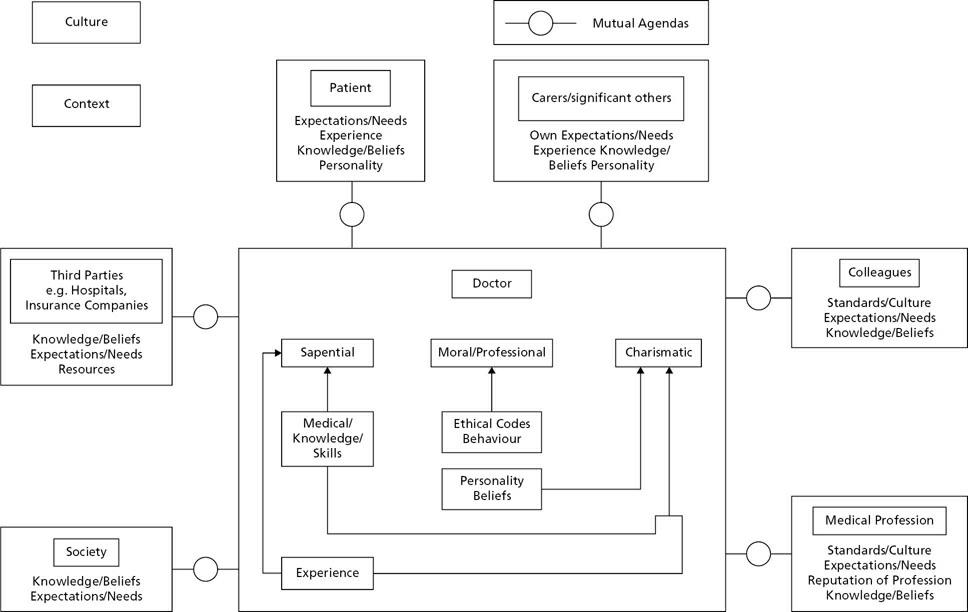The Medical Model in Mental Health
An Explanation and Evaluation
Ahmed Samei Huda
Consultant Psychiatrist
Pennine Care NHS Foundation Trust
Ashton-under-Lyne Lancashire, UK
Great Clarendon Street, Oxford, OX2 6DP, United Kingdom
Oxford University Press is a department of the University of Oxford It furthers the University’s objective of excellence in research, scholarship, and education by publishing worldwide Oxford is a registered trade mark of Oxford University Press in the UK and in certain other countries
© Oxford University Press 2019
The moral rights of the author have been asserted
First Edition published in 2019
Impression: 1
All rights reserved. No part of this publication may be reproduced, stored in a retrieval system, or transmitted, in any form or by any means, without the prior permission in writing of Oxford University Press, or as expressly permitted by law, by licence or under terms agreed with the appropriate reprographics rights organization Enquiries concerning reproduction outside the scope of the above should be sent to the Rights Department, Oxford University Press, at the address above You must not circulate this work in any other form and you must impose this same condition on any acquirer
Published in the United States of America by Oxford University Press 198 Madison Avenue, New York, NY 10016, United States of America
British Library Cataloguing in Publication Data
Data available
Library of Congress Control Number: 2019932856
ISBN 978–0–19–880725–4
eISBN 978–0–19–253409–5
Oxford University Press makes no representation, express or implied, that the drug dosages in this book are correct. Readers must therefore always check the product information and clinical procedures with the most up-to-date published product information and data sheets provided by the manufacturers and the most recent codes of conduct and safety regulations. The authors and the publishers do not accept responsibility or legal liability for any errors in the text or for the misuse or misapplication of material in this work. Except where otherwise stated, drug dosages and recommendations are for the nonpregnant adult who is not breast-feeding
Links to third party websites are provided by Oxford in good faith and for information only. Oxford disclaims any responsibility for the materials contained in any third party website referenced in this work.
Preface
I wrote this book in order to explain the medical model and to evaluate its usefulness in mental health. The inspiration was twofold. Having read many critical comments about the medical model in mental health, it struck me that many of these criticisms seem based on a lack of knowledge or misunderstanding of the medical model, not just in psychiatry but also in general medicine.
There seemed to be an assumption that doctors in general medicine and general practice and other specialties treated diseases with known pathologies and that they offered very effective treatments that ‘cured’ diseases. Psychiatrists, in contrast, treated ‘non-existent’ diseases with ineffective and very toxic drugs. This set of assumptions did not seem to accord with either the research evidence or my own experience in clinical practice.
The second inspiration came when I was reading a textbook on general medicine Davidson’s Principles and Practice of Medicine (22nd Edition) by Walker and colleagues (2014) as part of my continuing professional development. I took notes whilst revising and realized that many of the concerns about psychiatric diagnostic constructs and the effectiveness of treatments also occurred in general medicine. These notes form an important part of the later section of this book where I discuss how psychiatry compares to general medicine.
The apparent contrast between a pristine and scientific general medicine with its miraculous cures and a discredited psychiatry with its ‘snake-oil’ poisons was a mirage. To come to a more accurate conclusion it seemed that the best method was to define what the medical model was and then to discover the best criteria and standard for determining the effectiveness of its diagnostic constructs and treatments. The best standard for judging the criteria is to compare psychiatry with general medicine.
I have not found any recent book that addresses this issue so I decided to write my own. The classic books on the subject of psychiatry’s concepts include a posthumous second edition of a book published in 1980 (Clare, 2011), the text by McHugh and Slavney (1998), and a more recent example by Ghamei (2007); none explain the medical model from the basics or make
as detailed a comparison with general medicine. I wanted my book to be accessible to a wide group of people, not just doctors. This wider group included other people who work in mental health psychologists, social workers, nurses and their students. I also wanted patients and their families and academics/professionals who are interested in mental health such as sociologists, journalists, and philosophers to be able to read and understand this book. This means that I have assumed no medical knowledge in the reader, which has a drawback in increasing the length of the book as I explain everything.
The question then arises as to my suitability to perform this exercise. My qualification rests mostly on my years of clinical experience and, in the absence of anybody else stepping up to the plate, I have tried to write something from the point of view of the clinical psychiatrist rather than an academic. I have worked as a consultant psychiatrist since August 2002 (including about one year in Australia). I am not an academic psychiatrist someone whose primary role is doing research but I do try to look at broader issues and keep up to date with current research developments as much as possible. I spend all my time doing clinical work including sometimes working a full day, seeing patients in the middle of the night, getting up in the morning and doing a full day’s work again. I only have 15 minutes to see patients for review outpatient appointments. This gives me a perspective on the importance of practical clinical usefulness that may escape my more academic colleagues. This has resulted in much of the book not being written in an ‘academic style’, which means I tend not to give references for statements that seem obvious or self-explanatory based on my experience. The earlier, more explanatory chapters tend to be less thick with references than the later chapters, which discuss the results of research. The simplest and most honest credential is that nobody else has done it recently, so I volunteered myself.
I have tried to be as accurate as possible and include the best-quality evidence throughout the book. I lay no claim to world-leading expertise in any of the subjects covered, so inevitably there will be shortcomings in both the evidence and analysis presented. What I am is interested in the field and I try to answer the questions as best as I can and to account for my intrinsic bias. I attempt to present the information fairly. It has been said that a highlevel academic expert is more likely to be biased when they review the evidence on a subject (Chapter 9, Greenhalgh, 2010). Perhaps academia
requires adopting ‘strong’ positions that lead to them ignoring evidence that contradicts the position they adopt and only talking about evidence that strengthens their point of view. I have seen books that are, frankly, biased and misleading about mental health but which try to spin this bias as a positive, by claiming to be ‘balancing’ the views with which they disagree.
This book is divided into three parts. The first five chapters explain the medical model and related issues and provide the background information. Chapters 6 and 7 are the ‘hinge’ of the book, where I review criticism of psychiatric diagnosis and treatment, respectively, and work out what are the relevant questions to ask to compare psychiatry with general medicine. In Chapters 8 to 16, I examine the usefulness of the medical model in mental health by discussing the evidence to settle the questions of how psychiatry compares to general medicine.
The amount of information and breadth of topics that I can cover means that a lot is left out and what is covered is done so very briefly. Important subjects that have been omitted include the effects of social factors on biology and a chapter on psychological factors in the aetiology of mental health problems. The latter was omitted as it was not one of the key questions to be addressed, but it is obvious to everyone the key role psychological factors have in psychological health issues (as well as in general medicine, but to a lesser degree). The tyranny of space allowed me has meant I sometimes use abbreviations. For example, I use the term ‘psychobiological’ not in reference to a Meyerian concept but as an abbreviation for ‘psychological and biological’.
When referring to doctors, except when referring to specific individuals, I will try to use female pronouns as most doctors are female.
Any mistakes in this book are my sole responsibility.
Finally, I hope the reader finds this book informative and useful.
Chapter 1
Explanation of basic concepts of medical terminology
A useful analogy can be drawn from John Steinbeck’s novella The Pearl. A poor pearl diver finds a large and seemingly flawless pearl. The diver takes the pearl to a buyer to get it valued. The buyer shows the surface of the pearl magnified by a lens to the diver. What seems flawless is, under closer inspection, revealed to be rough and pitted. The buyer then offers a price far under the true price of the pearl, arguing that it is marred and therefore is not as valuable as it seems. If the buyer can pay a price far below the true value, then it serves to increase the profit made.
The diver suffers in this situation from ‘information asymmetry disadvantage’. He lacks the knowledge that all pearls, when seen under a magnifying glass, are pitted and rough. The buyer knows this information and tries to exploit the diver by only showing the rough surface and not revealing this vital ‘comparative information’ (i.e. that all pearls look like this under the magnifying lens) to allow the diver to make a proper comparative judgement about the value of the pearl.
When people write about the faults in psychiatric practice and concepts, they often do so by comparing it to the rest of medicine. However, this omits the important comparative information. This may be because, like the diver, they lack knowledge of this comparative information and make assumptions about how scientific and effective the rest of medicine is. An example of this is to draw instances from general medicine of excellence in terms of practices and outcomes or depth of knowledge in the genuine belief that these are representative of all general medicine, and that, therefore, psychiatry appears worthless in comparison.
On other occasions, critics of psychiatry (like the buyer) are aware that their comparisons are flawed but they hope that the person they are addressing has an ‘information asymmetry disadvantage’ that they can
exploit. They point out psychiatry’s limitations without providing the information as to how it compares to medicine. A variant of this ploy is to cherry-pick examples of excellence from general medicine and claim they are a fair representation of the difference between general medicine and psychiatry.
The teaching of medicine focuses on practices and facts and not on their conceptual foundations. Often doctors know what to do, not why or what the nature of what they are doing is. Doctors are taught to be reflective about their practice nowadays, but this usually focuses on their actions (or sometimes their feelings) and not on underlying concepts. There is an absence of understanding of concepts in the medical curriculum (see the General Medical Council (GMC) and the United States Medical Licensing Examination (USMLE) websites for the UK and US medical student curriculum, respectively). Thus, they may have stereotyped and limited views of what a diagnosis is, or the fact that illness and disease are always objective entities clearly demarcated from health. In their writings on medical matters doctors may use these unrealistic concepts, and readers without medical training may accept these unrealistic concepts about medicine as the truth. Doctors may be aware that they are sometimes guilty of over-simplification and they occasionally state this explicitly, but generally, most writing on diagnosis assumes that the reader is aware of this reductionism. Thus begins a chain of misinformation that spreads to people who have no medical training and who accept these medical concepts as the ‘whole truth’. Therefore, they have an ‘information deficit’ and do not realize this, having, in good faith, read and accepted what doctors have written. They may then use these flawed medical concepts to write about medicine for people of similar professional backgrounds to themselves. This chain of misinformation then spreads like a virus.
The aim of this book is try and reduce ‘information deficit’ so that the reader can make up her or his own mind about the medical model in mental health. I will endeavour to be as fair as possible in describing and interpreting the evidence whilst recognizing that I cannot be perfectly neutral. Let me start by describing some essential concepts that are necessary to understand before progressing with the rest of the book.
This chapter will discuss the ‘consultation’ between a doctor and her patient. The doctor is said to have authority based on her knowledge, her professional behaviour, and her ability to influence the patient. The doctor’s
authority requires a framework of how to assess the patient and make clinical decisions. The medical model is one such framework: the doctor assesses the patient, recognizes a problem with associated knowledge, and then suggests a course of action based on this knowledge.
There is then a discussion of concepts such as ‘illness’, ‘disease’, and ‘health’. Is it possible to make an easy, comprehensive, and reliable definition of these states? How do we apply these concepts to mental health? Finally, there is a discussion of how the medical model is one way of helping people but often other perspectives are needed.
The consultation
The encounter between a doctor and her patient can be described as a ‘consultation’ and is ‘the central act in medicine’ (Chapter 1 in Pendleton et al., 1984). In this consultation, both the patient and the doctor have agendas. These agendas may be similar or may differ to various degrees. The ‘classic’ agenda is where a patient has a problem for which they think may need medical attention: they want the nature of the problem identified, what is likely to happen, what caused the problem, and what the doctor recommends as treatment. Other agendas may be present. A patient may need to get an episode of sickness certified so that work won’t punish them for taking sick leave. Another example is where a patient is detained against her will in a psychiatric ward and wants to convince the doctor that she does not need to be detained any longer. A doctor may want to ask a patient to take part in a research study. An unscrupulous doctor may wish to persuade a patient to accept unnecessary treatment in order to exploit her financially.
The doctor in this consultation is said to have three different forms of ‘authority’ by which is meant ‘the right to be heard’ rather than ‘the right to do what one wishes’ ‘sapiental’, ‘moral’, ‘charismatic’ (Chapter 1 in Pendleton et al., 1984). This translates into roles or functions (see Figure 1.1). ‘Sapiental’ authority is the authority that a doctor derives from her knowledge, skills, experience, and expertise; the consequent role or function would be her knowledge of medical conditions and how to recognize and treat them. ‘Moral’ authority refers to the authority doctors receive from society due to their adherence to a code of ethics placing the patient’s interests and care above all other interests as well as a ‘professional’ set of behaviours such as being respectful, attentive, willingness to attend patients
at all hours, and so forth.
Figure 1.1 The consultation.
I prefer the term ‘professional’ authority as doctors are not necessarily more ‘moral’ than others but are given authority by society because of the set of behaviours and attitudes that are characteristic of their profession. It may also derive, at least in part, from the doctor’s knowledge and claim to expertise in a specific situation. The result is that society permits doctors to perform certain roles and grants them certain permissions such as being allowed to ask patients about intimate bodily functions or personal matters, to touch the patient during physical examinations, or to make decisions on health in the patient’s best interests if they are incapacitated, or conduct evaluations on patients such as whether to allow access to healthcare, welfare benefits, or avoidance of punishment by the courts.
‘Charismatic’ authority is harder to define but refers to the ability of the doctor to persuade the patient to place their trust in her and believe that the doctor’s decisions and actions will benefit them. This can increase the chances of the success of the doctor’s proposed treatment, or at least the chances of the patient saying the treatment is successful. The doctor may
derive this authority from their own self-confidence (which could be entirely misplaced) or from some other aspect of their personality. Sometimes it can flow from other forms of authority; if a doctor is clearly highly ‘moral’, exhibits a great deal of professionalism, or has a high degree of ‘sapiental’ authority by being renowned for being knowledgeable or highly skilled.
The obverse of ‘charismatic’ authority can see a doctor seeking and displaying power in order to satisfy her own needs as well as to impress patients. This type of authority tends to be allowed greater ‘leeway’ in terms of behaviour and medical interventions so long as the results are positive. Another role may be that of ‘iconoclast’ (i.e. shaking up a previously established way of organizing or delivering medical care if it can be shown that the method they use is superior to the orthodoxy). Great care must be taken that doctors don’t confuse the authority bestowed upon them with licence to do what they want against the patient’s or others’ interests.
Other factors can influence doctors’ agendas such as society, culture, and context; for example, a patient may need a sickness certification as part of the requirements of the society they live in, others may not. An involuntarily detained patient may seek to persuade the doctor that they were well enough to be released from detention and sent home. Other factors may be the health beliefs of the patient; for example, if they demand an antibiotic to help them with an upper respiratory tract infection even if it is likely to be a viral infection and therefore an antibiotic is not an indicated treatment. The patient may have researched the possibilities of what could be causing their problem and might be seeking confirmation of what is wrong from the doctor or believes an investigation should be ordered. An unscrupulous doctor may try to exploit the patient. Personality, beliefs, and knowledge can affect all parties’ agendas, not just the patient’s. The start of the consultation should involve the doctor talking to the patient in order to discover what they want and then try and address their needs as best as possible.
Other parties are also involved in the consultation and have their own agendas. Often healthcare is paid for by a third party such as a health insurance scheme or a hospital or a government body. General practitioners (GPs) in the United Kingdom are usually self-employed but are paid by the National Health Service (NHS) for providing a primary care health service. These third parties have their own agenda in a consultation; they want effective health care to be provided but they also have an interest in costeffective care and sometimes outright cost containment. Their definition of
what is good quality health care and cost-effectiveness is influenced by their knowledge and beliefs and external constraints (such as budgets, directives, and guidelines on health care for certain conditions such as the National Institute for Health and Care Excellence (NICE) Clinical Guidelines). Medical care is very expensive so third parties are likely to want doctors to justify this expense. The third party expects the doctor to focus on providing healthcare based on their medical knowledge, skills, and experience in a professional manner. Given the expense, third parties expect doctors to see as large a number of patients as possible in as little time as possible.
Another example of third party involvement is when a doctor is asked for their medical opinion about a patient for a specific purpose. Examples include the courts (who may want to know whether a person is fit to stand trial), welfare agencies (whether a person is fit to work or how much care they need), or occupational health (if there are any health impediments to somebody carrying out a job). In these cases, these third parties are relying on the sapiental authority of the doctor to give an accurate knowledge-based answer and the professional authority of the doctor to give an impartial answer.
Society has input into the consultation, too. It has expectations of what it wants from doctors (for instance, to be knowledgeable, caring, professional, and honest) but also what patients can demand and get help for from their doctors. It was doctors’ professional authority (i.e. their ability to be held to account by relevant authorities, their ethical codes of behaviour, and their ability to be administrators) rather than sapiental authority (i.e. knowledge of mental health problems and effective treatments) that led to them being put in charge of asylums in the nineteenth century (Chapter 2 in Burns, 2006). If psychologists or social workers existed as highly developed professions with professional authority during the Victorian era, then perhaps they would have become asylum superintendents instead of doctors.
Patients’ carers, significant others, and relatives also have an agenda regarding the consultation. They (usually) have the patient’s best interests at heart and want to see them get better. Sometimes variations in the agenda between patients and their significant others exist: perhaps a patient regards an aspect of their presenting problem as not too troublesome but their spouse finds it highly bothersome.
Doctors’ colleagues such as nurses or other professionals also have agendas for the consultation. Perhaps they seek the knowledge of the doctor
to resolve a query about the patient’s clinical condition or deal with a clinical emergency, their sapiental role. These colleagues have their own knowledge bases and professional codes of ethics so only need from doctors what they cannot provide using their own sources of authority. They may need the doctor to confirm queries about health-related issues such as ability to walk a certain distance, capacity to make decisions, or to complete forms related to welfare benefits or other societal requirements.
The medical profession also has an agenda for consultations between doctors and patients. It derives societal authority and benefits from its good reputation. It therefore has an interest in making sure that consultation between doctors and patients does not bring the profession into disrepute. If the medical profession can reduce the frequency of inadequate or harmful practices by doctors and maintain a high level of good performance, then it can continue to justify doctors’ high prestige and salaries. For this reason, the medical profession is suspicious of ‘charismatic’ practices as they can often cause unintended harm.
I have been discussing the different agendas parties to consultations bring to that engagement between doctor and patient. Moving now to standards, there must be a balance struck between standardizing good clinical practice and stifling innovation that may lead to improvement. The medical profession tries to maintain sapiental authority by education and training; encouraging continuous professional development; taking part in medical research and publishing the results in the medical scientific literature in order to update the knowledge base of other doctors. Doctors maintain professional authority by devising and teaching codes of ethics and professional guidelines as well as having established professional bodies responsible for disciplining doctors for breaches of professional ethics, such as the GMC in the United Kingdom.
The sapiental role/authority also requires a system which organizes and uses medical knowledge (such as what types of problems patients present with, the likely course of these problems, how to detect and identify them, what interventions help, etc.), skills, expertise, and experience. It requires a framework to systematize how this knowledge is acquired, how it is improved through research, how it is recalled and used in consultations and other clinical situations to make decisions that benefit patients. This framework can be regarded as a ‘model’ (model in this case refers to a system that tries to represent a field of interest for a specific purpose).
The medical model
The medical model as described in this book refers specifically to a system that a doctor would use to help in clinical or research practice to help identify clinical problems, make predictions as to outcomes and responses to treatment of these clinical problems, and an underpinning, understanding, or explanation for these predictions that could also form the basis of research.
Throughout the ages, doctors have used a variety of medical models such as imbalances of bodily fluids (the ‘humoural model’) or disturbances of energy flows in the body. Even in the same era (such as ours), different doctors will use different models. In fact, the same doctor may use different models, depending on which clinical problem or condition he/she is dealing with at the time. Although they are closely intertwined, we should separate the medical model as a description of a model of practice of how doctors interact with patients in terms of methods of assessment, classification of their problems, and how they ‘manage’ their patients’ health problems from the various explanatory models that doctors used to explain their patients’ health problems to themselves and their patients.
People often refer to the ‘biomedical model’ and sometimes understand this incorrectly to mean a model that focuses exclusively on a person’s biology and biological interventions. The biomedical model also integrates the effects of culture, social factors, personal circumstances and beliefs, diet, upbringing, and so forth on health and illness. It can even accommodate the notion that psychological or social factors may be more important in the causation of certain conditions than biological factors and that the best intervention is not necessarily biological (e.g. medication) and often involves interventions based on psychological or social factors (Chapters 2, 3, and 4 in Guze, 1992). However, the biomedical model tends to view non-biological factors’ effect on health as due to their effect on an intermediate biological factor. Doctors increasingly prefer a biopsychosocial model of explanation of health problems (which has ancient roots in medicine such as in the writings of Hippocrates) and that recognizes the importance of psychological and social factors in their own right as important for explaining health problems (Engel, 1981). It is important to recognize that this model does not mean biological, psychological, and social factors carry equal weight as causes for every condition and in every individual, and it can easily lead to ‘trite’ and ‘sterile’ statements (Chapter 1 in Ghaemi, 2007).
In this book, I discuss specifically a model of medical care that involves assessing a patient, then making decisions and interventions based on this assessment, followed by monitoring the response to these interventions by further assessments which may lead to changes in decisions and interventions, and so on in a cycle of assessments/interventions/assessment of effect of interventions and changes in severity (see Chapter 5). These assessments are undertaken principally by talking to patients in order to acquire a medical history but also by performing a clinical examination, ordering any relevant tests, and seeking additional details such as information from relatives and/or carers.
The doctor then uses this information to make a diagnosis (or more than one diagnosis). They also incorporate other important information into a ‘diagnostic formulation’ (see Chapter 2), and decide on a management plan that incorporates discussing with the patient the likely range of outcomes and the choice of recommended treatments and further investigations. A simpler definition of the medical model has been proposed in which doctors advise on, coordinate, or deliver interventions for health improvement based on the best possible evidence and that it is more important to know that a treatment is effective than its mechanism of action (Shah and Mountain, 2007).
The medical model is sometimes described as a ‘disease-based model’. This is based on a misunderstanding that a diagnosis always refers to a disease that is clearly separate from other diseases and from optimal health, and that management of patients uses diagnoses focused on biological processes ignoring psychosocial factors In fact, as we shall see later, the medical model is a pattern recognition model: the clinical features of the patient are ‘matched’ to the clinical features of conditions that have been described in an existing body of medical knowledge (see Chapter 2).
To try to improve communication between themselves, doctors use standardized terminology which is often based on classical Greek. This is because of both the influence Ancient Greece has on Western culture as well as the specific influences of Hippocrates (and his ‘School’) and Galen, the pre-eminent Greek physician in Ancient Rome, on the development of modern medicine (Chapter 1 in Bynum, 2008).
‘Patient’ is the most commonly used term for the person being seen by the doctor (or consulting the doctor). Some prefer ‘client’, ‘consumer’, or ‘service user’: these imply a less deferential role and a more symmetrical power relationship with the doctor than the term patient. Even the very word
‘patient’ implies that the patient should be waiting at least in part for the convenience of the doctor. There are, however, disadvantages with being a patient in terms of an asymmetrical power relationship with the doctor, but there are advantages too.
Being a patient signifies that the person so designated is entitled to the protections and benefits offered by the doctor’s professional code (often based on the Hippocratic Oath) as well as those of professionals allied to medicine. Given that doctors are amongst the most trusted professionals (as are the professionals allied to medicine such as nurses, occupational therapists, physiotherapists, etc.), these benefits may be highly regarded.
Surveys of people with mental health and physical health problems found that 75–80% preferred the term ‘patient’ (McGuire-Snieckus et al., 2003; Deber et al., 2005). Interestingly, there is a more even split between this and other terms, such as ‘client’, in cases where the individuals concerned are seeing other professionals, such as social workers. This suggests that people are aware of the different nature of the interactions they have with health and social care professionals and the different implications of the various terms.
When dealing with an individual, a doctor should use the term that the individual prefers. For the purposes of describing a group of people who are being seen by doctors in their professional capacities, I will use the word ‘patient’ throughout this book. There are good reasons why other terms are preferable but ‘patient’ seems an acceptable term to many people seeing a doctor.
‘Symptom’ refers to what a patient tells you about what they are experiencing. This is often ‘grouped’ or ‘translated’ into a medical term that is used as an umbrella term for similar descriptions of experiences by other patients (Chapter 1 in Brush, 2015). Sometimes this is expressed in plain English; other times a standardized medical term is used. For example, a patient may say ‘I can’t lie flat as I get breathless’, which the doctor may record ‘breathlessness on lying flat’ or ‘orthopnoea’.
The ‘medical history’ is a record of the information that the patient relays to the doctor. Apart from symptoms, other important information is sought such as age, gender, marital status, employment, family history of medical problems, past medical history, medications allergies, etc. Patients are questioned further to allow a more exact classification of their symptoms (e.g. timing, triggering, exacerbating, and relieving factors, and so on).
There is a systematic process drummed into medical students as to how to
ask these questions, how to order them, and then how to record them. The aphorism is that 90% of the time a diagnosis can be made from the patient’s history alone. A study looked at referrals to consultants in general medicine from their GP (Hampton et al., 1975). Most of the patients had already received a diagnosis from their GP. In 66 out of 80 patients, based on the history alone (i.e. just over 80%) and reading the referral letter from the GP, the consultant was fairly confident in their diagnosis. A further seven patients required a physical examination to be confident of the diagnosis whilst seven patients required physical investigations to make the diagnosis.
‘Signs’ are features of the patient that are detected by the clinician though observation and examination. They may include a wide variety of possibilities from rate of breathing, rashes on the skin, lumps, movement and speech abnormalities, unusual facial expressions, and so on. They may also include an absence of a feature or a reduction in a normal attribute or behaviour that would one expect to find, for example a missing finger or a silent chest with reduced or absent breath sounds. The more reliable the sign, the more likely different clinicians are to agree on the presence or nature of the sign. Something can be both a symptom and a sign (such as a patient complaining about a fever). The different signs are again ‘grouped’, based on similarities to signs observed in other patients (e.g. shallow breathing, different types of rashes, abscesses, and so forth).
For thousands of years, the patient’s description of what has happened to them, their symptoms and signs, along with the timings of fluctuation of the severity of these symptoms and signs were the mainstay of the information that the doctor could acquire about the patient, apart from some simple bedside tests such as tasting the urine in patients with profuse urinary outputs to see if it was sweet like honey (with the patient diagnosed with diabetes mellitus) or very weak-tasting (the diagnosis being diabetes insipidus).
This information would be collated to form a ‘clinical picture’. Both symptoms and signs would be translated into standardized terminology (even if the patient’s own words were used in conversation with them). This was to facilitate communication between colleagues who would be discussing the same phenomenon. This standardized terminology was also used in textbooks, meaning that doctors had to translate how the patient described their health experiences into this standardized terminology in order to match it to what was learned from textbooks. The clinical picture would not just comprise symptoms, signs, fluctuations, and the results of any tests but also
the description of what has happened to the patient and their personal details. Demographic data such as age, gender, what job the patient had, what effects their environment had on their health, what illnesses were commonly found in the patient’s family, and other information that was felt to be clinically relevant were included in this overall picture. Hippocrates is reputed to have said ‘it is more important to know what sort of person has a disease than to know what sort of disease a person has’.
This wider viewpoint of what is important to know about patients, not just their type of illness, has been claimed as inspiring many complementary traditions. It is, however, the direct forefather of the biopsychosocial medical model, which looks at the multiple influences on the person that influence health and what is perceived as good health. This model is more clearly seen in psychiatry but it is there, lurking in the background of all medical specialties to a greater or lesser degree. Traditionally, when doctors present cases to each other it usually begins with a brief demographic statement about the patient, ‘This 62-year-old businessman presents with a typical history of . . . ’ . It can also be seen as the root of many psychosocial models of distress, even if they eschew this distress being seen as a ‘health’, let alone an ‘illness’ issue.
Health, illness, and disease
The definitions of illness, health, and disease are the subject of extensive debate amongst philosophers of medicine. It is particularly relevant in mental health for reasons we shall discuss later in this chapter. This subject could occupy the rest of this book. If the reader is interested there are many books on this topic. I recommend Psychiatry and Philosophy of Science (Cooper, 2007) and Concepts of Psychiatry (Ghaemi, 2007). A good website that discusses how concepts of health and illness are based on objective criteria and the influence of social values can be found at <http://plato.stanford.edu/entries/health-disease/>.
Doctors are seen as primarily interested in illness and disease as opposed to health (although as we shall see later, doctors are involved with situations that are not regarded as illnesses). ‘Illness’ is a tricky term to define precisely. It is generally thought of as an often unpleasant state that is more than just the presence of disease (even if a disease can be identified) but also incorporates features specific to the individual such as their particular
experience and personality (Chapter 1 in Pendleton et al., 1984). Patients with illness present to their doctor who may then try to discover if an underlying disease is present causing the illness (see Chapters 3, 4, and 5). Most of the discussion that follows uses the term ‘disease’ rather than ‘illness’ as ‘disease’ is the term that tends to be used in relevant philosophical discussions.
It is easier to describe (and recognize) examples of disease than to give a watertight definition that encompasses all states and conditions commonly (and uncommonly) regarded as diseases that also demarcate them neatly from states regarded as ‘healthy’ using purely objective measurements and terms. In other words, somewhere along the line we must include more subjective measures such as judgement of a professional. This professional in the case of diseases is usually, but not always, a doctor.
Trying to define disease in terms of subjective distress caused by the state so labelled would exclude some types of disease in which the patient doesn’t recognize an obvious deficit of functioning due to a brain problem such as a stroke causing anosognosia (an inability to recognize a disease or illness present). Other states that would be excluded from this definition include asymptomatic carriers of infectious disease such as ‘Typhoid Mary’ although in cases like this, a test can be used to identify the presence of an infectious agent, but this relies on the presence of a capability to perform such a test. Examples such as high blood pressure are often asymptomatic but they are associated with increased risk of diseases like heart attacks or strokes. Of course, they have an objective element the measured blood pressure but this criterion of objective difference and increased risk of definite disease would also classify pregnancy as disease, which would be wrong (leaving aside the problem of demarcating neatly what blood pressure figures should be regarded as healthy and which should be regarded as disease).
Definitions that rely on abnormal functioning or harm flounder on defining exactly, without confounding examples, how such abnormal functioning or harm is to be demonstrated. Often what is decided as abnormal functioning or harm involves subjective judgement by a doctor. This can be regarded as a normative judgement. By this I mean a professional healthcare worker, in this case a doctor, makes a decision as to whether something is ‘normal’ or ‘notnormal’, in this case specifically a disease. The professional should make this judgement based on their professional knowledge and judgement. People,
including doctors, disagree on whether specific states are diseases (Tikkinen et al., 2012).
Historically, these judgements were made before an accurate knowledge of the scientific basis of causation of these states. Doctors, and other professionals, made a judgement of a state being a disease often founded on a belief that this state differed from health, based on stress or harm caused to people or the risk of harm to self or others (‘Typhoid Mary’ had no symptoms but was regarded as having a health problem due to the risk she posed to others), and further that this state was appropriately regarded as a disease or at least a state suitable for medical attention by the society in which the doctor lived (Ereshefsky, 2009). Hippocrates stated that epilepsy, regarded as a sacred illness bestowed by the gods, could also be regarded as an illness for doctors to treat. He did this in the absence of the knowledge that it was caused by unusual electrical activity in the brain (or any way of proving this); the explanation used by ancient doctors was that it was caused by an imbalance of humours (bodily fluids) (Chapter 1 in Bynum, 2008).
What was regarded as disease will also vary, depending on the society the patient inhabited. Clare quotes the example of a South American tribe who regarded coloured skin spots caused by dyschromic spirechotosis (due to a treponemal infection) as a precondition for getting married and the absence of such skin spots as a sign of abnormality (Dubros, 1965; Chapter 1 in Clare, 2011). This is an example of how social values and their role influence and, in some cases, decide what ‘disease’ is. Of course, there are many examples of obvious disease that most or even all cultures would accept as such. People coughing up blood would be regarded by most people as being self-evidently diseased. However, there are also examples as described above where different societies or social groups (such as professionals) or different individuals will disagree about whether a condition constitutes a disease or not.
There is also the question of what measurements used to demonstrate demarcations between health and disease are truly ‘objective’, by which I mean that the results of such measurements and demarcations are completely unaffected by subjective judgement at some point and/or whomever observes and interprets these measurements. At some point in the creation of these measurements, the conception of these measurements, and the observation of these measurements, there is an element of subjectivity. Certainly, in the assigning of measurements to ‘disease’ or ‘health’ most research starts from
the basis of a judgement as to what is ‘health’ or ‘disease’, then identifying what range of measurements are associated with either state. We then come to the issue of how people observe and finally interpret these measurements (assuming the measurements are observed by a completely perfect process). Even when examining clinical signs, there is often a degree of interpretation by the observer, often seeking a verbal confirmation from the patient (‘does it hurt if I do this?’) (van Praag, 1992). It seems that true objectivity is hard to demonstrate and, not for the first or last time, there is a ‘dimension’ of objectivity/subjectivity. Some methods or demarcations are ‘more objective’, others ‘more subjective’.
Disease seems objective in that it suggests a demonstrated abnormality of structure or function, it seems to represent a state independent of the observer but there are elements of subjective judgement involved. This abnormality is clearly demonstrated using tests or investigations such as X-rays, microscopic examination for bacteria, or even more subjective tests such as an extreme score on questionnaire measuring psychological phenomena. This difference is supposed to be clearly seen between states of health and between different examples of disease.
Unfortunately, the concept of disease is also subjective in several respects. First, the process of demonstrating a disease process involves an initial step of labelling a condition or state as a type of illness and then performing research to see what differences in structure and/or functioning is associated with this type of illness, which is called disease (see Chapters 3 and 4).
Second, when interpreting the findings of any investigations there is often a point at which subjective judgement by a professional is involved (even if this is an informed judgement). For example, when examining a microscope slide for cells displaying signs of transforming into cancerous cells, there is a gradient or dimension of increasing signs of being a cancer cell. The pathologist must interpret where on this dimension the cell lies and to give a judgement as to which category the cell is best allocated. What is more, another pathologist looking at the same slide may disagree as to the most appropriate category. Even when bacteria are present in the body there is still an element of judgement regarding whether it is a pathogen causing disease (Casadevall and Pirofsky, 1999).
Third, in order to demonstrate what is abnormal, you have to be confident you have the capability to measure abnormality as well as being able to measure and demonstrate normal functioning. Unfortunately, for certain
bodily functions and systems, our knowledge of how to measure and demonstrate even ‘normal functioning’ is beyond us. The most obvious example is higher brain functions such as thinking, emotions, and memory. If you cannot accurately and reliably measure and demonstrate ‘normal’ functioning (assuming you can satisfactorily establish what is ‘normal’) then you cannot demonstrate and prove ‘abnormal’ functioning. Thus, rules or definitions of how to define abnormalities of structure or function reliably run into difficulties and perhaps a messy solution is best (see Chapter 3 in Cooper, 2007).
Fourth, the very concept of what a disease is has varied with culture and history (Wulff, 1999).
In summary:
◆ It is easier to give examples of disease and to recognize clear examples of disease (i.e. they are prototype concepts see Chapter 3) than to create a comprehensive water-tight definition of disease that clearly demarcates it from health and applies for every type of health state that is regarded as a disease.
◆ Disease is usually labelled as such based on whether it involves harm (such as distress, discomfort, impaired functioning, or damage to bodily functions or structures) or elevated risk of causing a more clearly recognized illness in the patient or others.
◆ The judgement by the professional as to whether a condition should be regarded as disease can be more or less/not contentious depending on the nature of the condition.
◆ Decisions as to whether a state of a patient’s health is to be regarded as a disease will always involve elements of subjective decision-making: the health professional’s judgement (a normative judgement) and the views and values of the patient’s society help to decide what changes constitute illness or disease.
Disease and illness, if thought to be dependent on presence of disease, are concepts involving subjectivity. Concepts of disease involve ‘biological, sociological, political, philosophical, and many other considerations’ (Chapter 4 in Schoenbach and Rosamond, 2000). Health is also tricky to define clearly and reliably and separately from illness or disease (Chapter 3 in Pendleton et al., 1984). The World Health Organization, in its Constitution of 1946, famously defined health as ‘a complete state of physical, mental and
social well-being, and not merely the absence of disease or infirmity’.
Sir Aubrey Lewis, the Australian psychiatrist, said of this definition that nothing could be more ‘comprehensive than that, or more meaningless’ (Lewis, 1953).
How many people’s ‘health’ would meet this definition? If it does not meet this definition does this mean people are unhealthy, ill, or even diseased? Who decides if somebody has ‘well-being’? Health proves to be another tricky concept to define reliably and satisfactorily. Health, like illness and disease, is easier to recognize but much harder to define in a value-free way that reliably identifies people who are healthy from people who are not, and in a manner with which everyone will agree.
Disease and illness are terms that imply that the states thus labelled are definitely medical problems and appropriate for doctors to assess and to treat. There are many examples of cases where this would not be contested, and most would agree that it is appropriate for medical attention be directed towards these. The issue becomes more contestable in more marginal examples. ‘Disorder’ has been suggested as a substitute term for disease, using the criteria of presence of harmful dysfunction, involving both scientific and social value judgements (Wakefield, 1992). I will use the term ‘condition’ instead. Although this term has medical connotations, these are not as strong as they are for disease and illness and it sounds less harsh or judgmental than ‘disorder’. By ‘condition’ I mean a description of a state in a person that may come to the attention of health services (Ereshefsky, 2009) but does not mean that this state is definitely an illness or disease, or even a state that should be regarded as a primarily a health problem (instead of, for example, a social problem). Some conditions should not be regarded as an illness or disease at all, although they may be regarded as suitable for medical attention, like pregnancy.
Given the element of subjectivity and the role of professionals in deciding which conditions constitute illnesses or diseases, is it the case that conditions labelled as illnesses or diseases should only be viewed with the medical model? Emphatically, no! Many conditions can and should be viewed using multiple models. For example, the social model of disability is far more useful for planning adaptations to the environment, allowing maximal participation by everyone in society. This model identifies what the barriers are to participation by people in society: an obvious example is stairs, with no ramps, as a route of access to a building.
The medical model can thus be viewed as follows:
◆ One way of conceptualizing and helping a condition and not necessarily the only way.
◆ Not automatically the best way of helping to achieve all or indeed any desired outcomes.
◆ A model that is willing work in conjunction with other models, in a multi-model, multidisciplinary way (i.e. with others such as carers, other professionals), each contributing a part to achieve desired outcomes.
◆ A model that at times may be unhelpful or even harmful for certain conditions.
Hippocrates illustrates this with his views on epilepsy, the so-called sacred illness. Although he was of the view that epilepsy had natural causes, this did not mean it was not also a sacred illness, in the sense that it had a spiritual dimension. This is an example of what has been described as ‘promiscuous realism’ (Dupre, 1996), the theory that there are often multiple ways of viewing the same subject. Each different view or way of viewing or representing the subject illuminates a different aspect, the implication being that amalgamating these different views gives you a better glimpse of the whole subject. The model that you use in a situation depends on how useful it is for you to achieve the goals that you seek; for example, trying to reduce the chances of a harmful outcome in a patient or reducing symptoms.
A parable illustrating this view is the story of the blind Indian men encountering an elephant. One felt the trunk and pronounced it was a snake, another felt the flank and said it was a wall, and so forth. They are only describing what they are experiencing from their perspective. One can argue that they are making the mistake of assuming that what they experience is the sum of what should be said of the subject and that they do not realize it is only a fragment of the whole. If they discuss their own conclusions with each other they can put all this information together and come up with a complete picture of an elephant rather than the individual parts they each feel.
We have discussed the influence of subjectivity on deciding what is illness and disease. In The Myth of Mental Illness Szasz was concerned that deviant, albeit ordinary, human behaviours and problems were being ‘pathologized’ for the purpose of social control (Szasz, 1960). His contention was that ‘medicalizing’ a particular condition/behaviour was justified only if an objective disease defined as either a structural or functional abnormality of
an organ—could be demonstrated.
There are several problems with Szasz’s view, but the most relevant one for this book is that it is too prescriptive to be of any use in an applied science such as medicine. Generally speaking, conditions are ‘medicalized’ before causal understanding is obtained. This is especially the case in psychiatry, since our understanding of the mind–brain functioning is still unfolding.
We are unable to demonstrate the biological processes creating, for example, thoughts. Since we are unable to demonstrate the processes of ‘normal’ mental functions of the brain, it follows that we may be unable to demonstrate ‘abnormal’ mental functions unless they are caused by obvious structural abnormalities (such as brain tumours causing mental symptoms), or obvious functional abnormalities (such as the dysregulated electrical activities in epilepsy), or they are the same pathological processes found in the rest of the body (such as autoimmune diseases causing behavioural abnormalities). This set of problems has been referred to as ‘the mind–brain problem’ (Chapter 1 in McHugh and Slavney, 1998). It is possible that we will never properly understand the physical underpinnings and functions of the mind (Chapter 6 in Guze, 1992).
Hence, if we have an imperfect knowledge of bodily systems, as we do for the higher functions of the brain, we cannot tell if abnormality of function or structure precedes or causes the behaviour labelled as an illness. Szasz argued that we should only label states or conditions as illness if we can definitely demonstrate disease. In a debate with Szasz, Clare pointed out that this meant, for example, that tuberculosis could not have been regarded as an illness until the causative bacteria was discovered by Koch in the late nineteenth century; the millions of people dying of ‘consumption’ or tuberculosis, as we now call it, were purportedly dying of a purely social construction until that moment. This was a definitive argument that Szasz was unable to counter (Chapter 8 in Clare, 2011). We should remain cautious of applying the label of illness to conditions when we do not have an objective confirmation of a disease process validating this label.
Tuberculosis is an example of diagnosis with clinical benefits (‘utility’), in this case recognizing the risk of death, the need for medical intervention, and an explanation for the symptoms and signs of the patient, before the discovery of adequate scientific knowledge explaining the cause of the diagnosis (‘validity’) and ultimately leading to the discovery of more effective treatments. Doctors are clinicians who use science in order to
benefit their clients. Before they had adequate scientific knowledge they still offered benefits to their patients such as placebo benefits from treatments they prescribed and developed clinical concepts and practices that were found to be useful. If doctors had discovered that magic or witchcraft was superior to science, they would have abandoned science and embraced eye of newt and toe of frog!
Our knowledge of both the normal and abnormal functioning and structure of the body is incomplete. The immune system, for example, contains much that we still don’t understand but of all bodily organs, the brain remains the greatest mystery.
Conclusion
Doctors embody three types of authority that transform into roles or functions: sapiental (e.g. knowledge), professional (e.g. ethical codes of behaviour), and charismatic (the ability to persuade the patient to obey the doctor and have faith that they will benefit). Fulfilling the sapiental role requires doctors to have a framework to work in or model to learn, and to use their knowledge. Not all interactions between a doctor and patient will make use of this model.
The medical model refers to both how a doctor assesses a patient and manages her health problem, as well as an explanatory model used by doctors to illuminate the health problem at hand. Doctors prefer a biopsychosocial model that takes into account biological, psychological, and social factors as an explanation of health problems. It is easier to give examples of disease (we can use the broader term ‘illness’) than to create water-tight definitions of disease. There is often a medical professional’s normative judgement that the patient is presenting with a disease. ‘Disease’ implies a demonstrated abnormality in the patient of structure or process that explains the health problem (though even this often involves normative judgement). ‘Condition’ refers to a state that is associated with distress or harm or risk of harm to the patient or others. Some conditions thought suitable for medical attention are not illnesses or diseases, such as pregnancy.
People have argued that for an illness to be present there must be demonstrated disease, but, amongst other reasons, this is a false argument as this assumes a current perfect state of knowledge as to what, precisely, constitutes a disease. This definition of demonstrated disease is particularly
difficult to apply in mental health as we know little about the normal functioning of the brain, let alone abnormal functioning.
The medical model, as a way of working to help people with health problems, is one way of helping people, a model of practice. There is also a medical model of viewing and explaining these problems, a model of explanation. ‘Promiscuous realism’ and practical experience suggests there are multiple models of viewing people’s problems, and multiple ways of helping people with these problems. The medical model is not necessarily the best way to view or help a problem. Doctors work with other professionals who use other useful explanatory models and/or ways of working with people.
